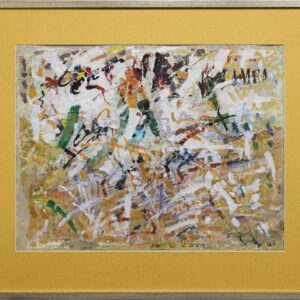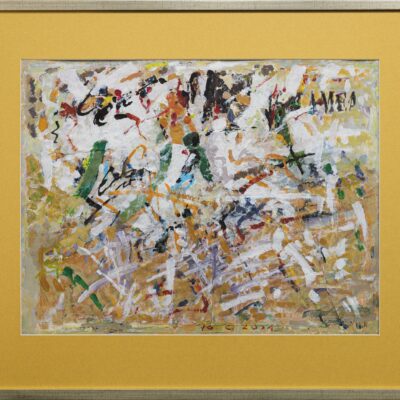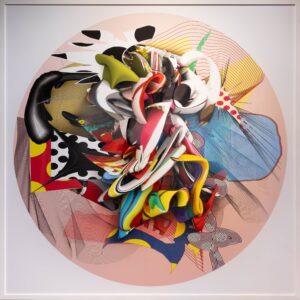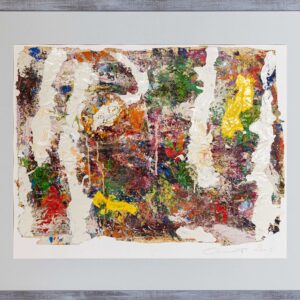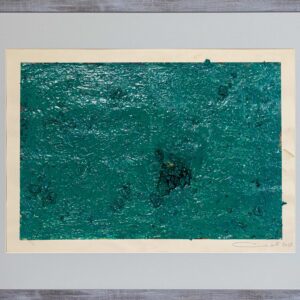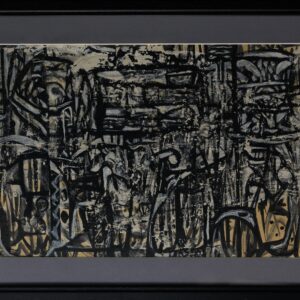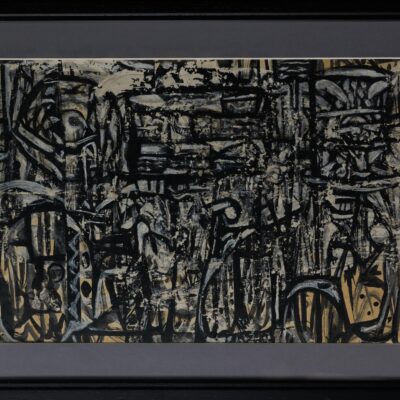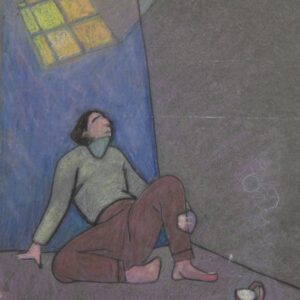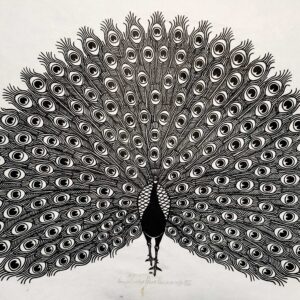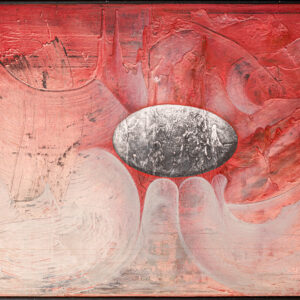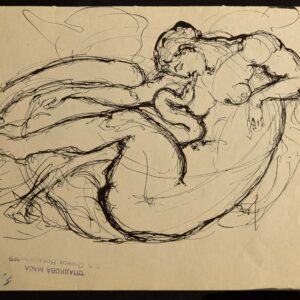Showing 81–91 of 91 results
Filters-
Світлана Юсим «Абстракція»
Starting bid 900$Svitlana Yusym (1941) was a Ukrainian modernist artist who worked in the field of abstract expressionism. Her creative practice encompassed painting, graphics, and collage. Her art bridges two eras—the late Soviet period and the decades of Independence—marked by radical transformations and new challenges.
The painting "Abstraction" (2004) conveys energy and movement through the interaction of color fields, lines, and textures. The tension between organic and geometric forms adds dynamism and balance to the composition. Rich color contrasts and layering create an immersive experience in the realm of visual perception.
The early 2000s became a period of intensive experimentation for Yusym, as she explored abstraction, light, color, and new means of artistic expression. Her works from this time are characterized by multilayered meaning, a deep spatial dimension, and a harmonious combination of spontaneity and deliberate structure.
-
Stepan Ryabchenko "Electronic Marshmallow (on pink)", 2008
Starting bid 17000$Stepan Ryabchenko (1987) is a Ukrainian artist who works with various mediums. With the help of bright installations, sculptures, and paintings, the artist creates his universe, inhabited by surreal creatures, fantastic plants, and animals - a reflection of an alternative reality where everything functions according to his rules. Ryabchenko's works are part of many private collections, including the Abramovych Foundation, Artsvit Gallery, Grynyov Art Collection, Korban Art Foundation, Luciano Benetton Collection, Sky Art Foundation, Stedley Art Foundation, Triumph Gallery, Voronov Art Foundation, Lars Malmberg Collection, Luciano Benetton Collection, Firtash Foundation, Arts Trend Company, Zenko Foundation. In 2021, the British publication Electric Artefacts included him in the list of the best digital artists.
In his creative pursuits, Stepan Ryabchenko studies new computer technologies and their limitless possibilities. "Electronic Marshmallow" is a fragment of the "Electronic Winds" project. As a base of the project, the artist takes ancient Greek myths, translates them into the language of digital technologies, and seeks relations between the real and the virtual. Stepan Ryabchenko creates his mythology of the virtual universe as the only place where you can be truly free.
-
Тіберій Сільваші «Без назви», 2005
Starting bid 2500$Tiberiy Silvashi (1947) is a Ukrainian painter who works in the direction of abstract art using his creative method. In the 1970s, the artist began his research into the very essence of the substance of painting and, at the same time, formed the core concept of "chronorealism" for his aesthetics. In the late 1980s – he founded the informal association of abstractionists "Painting Reserve". In the 2000s, he moved to spatial objects – painting and installation projects, exploring the question of the existence of painting outside the boundaries of the picture. The main object of Silvashi's research today is monochrome painting. The artist's works are kept in public and private collections in Munich, Vienna, New Jersey, Zaporizhzhia, Kharkiv, Uzhgorod, Kyiv and other cities in Europe and the USA.
For Silvashi, color is the matter through which he translates his attempts to understand the world. There is no need to look for meaning, story, or structure in his work. Here, color is the primary thing: the interaction of colors and shades, the dialogue between them, the texture of layering, and the unevenness of the plane. By passively observing these actions on the plane, the viewer is fulfilled, goes beyond the usual sense of Time, and throws himself into Silvashi's "chronorealism", where the connection between the flow of Time and the flow of Color is formed.
-
Тіберій Сільваші «Без назви», 2018
Starting bid 2500$Tiberiy Silvashi (1947) is a Ukrainian painter who works in the direction of abstract art using his creative method. In the 1970s, the artist began his research into the very essence of the substance of painting and, at the same time, formed the core concept of "chronorealism" for his aesthetics. In the late 1980s – he founded the informal association of abstractionists "Painting Reserve". In the 2000s, he moved to spatial objects – painting and installation projects, exploring the question of the existence of painting outside the boundaries of the picture. The main object of Silvashi's research today is monochrome painting. The artist's works are kept in public and private collections in Munich, Vienna, New Jersey, Zaporizhzhia, Kharkiv, Uzhgorod, Kyiv and other cities in Europe and the USA.
For Silvashi, painting is a ritual; when applied layer by layer, paint creates a physical substance of fixed time, and his paintings are objects of color. In this painting, a story takes place between the different layers of paint, a dialogue between the color and the painter. The dialogue is embodied in the reflections of light, the shadows that appear due to the texture of dried oil, and the slightest changes in colored matter. Contemplation of this dialogue pulls the viewer out of real-time.
-
Федір Тетянич «Абстракція»
Starting bid 3500$Fedir Tetyanych (1942-2007) — was a prominent artist of Kyiv’s underground scene, a pioneer in the fields of futurology and conceptual art. A significant part of his work was dedicated to the idea of the fantastic country "Fripulia," which he brought to life through installations, actionist projects, and easel painting. He saw his life in art as a continuous process of creative experimentation.
The artwork "Abstraction" is one of the sketches from the "Fripulia" series and demonstrates his approach to monumental composition with structured signs. The piece conveys a sense of continuous movement and subconscious image creation, where each element interacts with another, forming a complex dynamic scene.
The 1980s were a period of active development for Tetyanych’s artistic concepts when he explored new approaches to visual language, striving to expand the boundaries of painting. His works from this time are distinguished by their powerful energy, the breaking of traditional compositional canons, and the pursuit of something beyond the conventional perception of art.
-
Fedir Tetyanich "Madonna and Child", 1970s
Starting bid 2000$Fedir Tetyanich (1942 – 2007) is a Ukrainian painter, conceptualist, and performer. He invented the imaginary country "Fripulia", which grew from the ideas of a cybernetic Paradise, the possibility of life in open space conditions. Country "Fripulia" became the basis of the artist's life and work. This phenomenon grew into "biotechnospheres" - installations and parts of the artist's performances, spherical constructions, where everything is necessary for human survival during a disaster. The artist's works are kept in national and private museums of Ukraine and the USA, as well as in auction houses. His mosaic panels decorate the facades of the Kyiv Polytechnic Institute, the "Flowering Gardens" shopping center, 1976.
Fedir Tetyanich is one of the first to discuss the possibility of a future apocalypse. His "Madonna and Child" is executed in the iconographic type "The Virgin of Warning". The heavy monolithic forms of Maria and her son stare into the viewer and interact with him, provoking emotions. The child's raised hand covering the Mother's face warns of danger. The work was painted before the Chornobyl disaster and symbolizes the state of society, which was terrified by the future. The Mother of God trying to cover her son with her hands symbolizes all the innocent. On the other hand, Christ calmly observes and forces us to recover, to look at the consequences of thoughtlessness and arrogance.
-
Юрій Скандаков «Політичний», 1970
Starting bid 700$Yuriy Skandakov (1932–2007) was a Ukrainian artist who worked in easel painting, graphics, decorative and applied art, and theatre decoration. The artist's creativity is a kind of improvisation; he created smoothly, was not afraid to experiment, and looked for inner expression in his characters. The artist used color freely, looked for attractive formal solutions and unusual poses, combined decorativeness with sensuality, and created powerful psychological images. During his lifetime, Yuriy Skandakov participated in more than 100 exhibitions, including those in Armenia (1971), Poland (1980), Spain (1981), and Hungary (1983). In 1984, he had a personal exhibition in Lviv. Exhibitions in memory of the artist were held in 2018 - «Soul of Lviv» in the art salon «Veles» and in 2020 – "Return of the Phenomenon" in the "Chocolate House" of the National Museum "Kyiv Art Gallery" in Kyiv.
"Political", 1970 – a reflection of the dissident movement of the 1960s. In the center of the composition, we see a man cornered, confined by the narrow confines of a prison cell. Despite everything, he does not give up and refuses food as a sign of his opposition. Emphasis is placed on his inner freedom, the struggle for personal rights. The man is depicted in an open pose, and his face is directed upwards – towards a single ray of light, which is involuntarily associated with such desired freedom.
-
Яків Гніздовський «Голубий павич», 1980
Starting bid 1000$Jacques Hnizdovsky (1915 – 1985) is a world-famous Ukrainian graphic artist. He worked in easel painting, sculpture and ceramics, but he gained the greatest fame as a graphic artist. He worked in wood engraving, linocut and etching techniques and created about 375 prints. His works got recognition in the art centres of Great Britain, West Germany, Czechoslovakia, Japan, countries of Africa and the Middle East. The artist's works are stored in the Library of Congress, the Boston Museum, the Philadelphia Museum, the University of Delaware, the University of Washington, the Butler Institute, the Woodward Foundation, the collection of Nelson Rockefeller in the USA, in museums in Japan, as well as in numerous private collections around the world. Two of his paintings – "Winter Landscape" and "Sunflower" – decorated the office of US President John Kennedy in the White House.
"Blue Peacock" reflects the forced migration to the USA. After the move, Yakov Hnizdovskyi felt very confused; he could not adapt for a long time. He sought salvation in work; every day, he went outdoors to the zoo and the botanical garden not far from his New York apartment. Plants and animals evoked compassion in the artist. In fact, he identifies them with himself - a lonely emigrant lost in the frantic urbanized rhythm of another country. A characteristic feature of Yakov Hnizdovsky's engravings is the combination of detailed realism with stylization. The depicted object has all the characteristic recognizable features, and at the same time, being abstracted from the specific environment, acquires decorative features and becomes a symbol. The work "Blue Peacock" is presented in the Abe Tahir "Jacques Hnizdovsky. Woodcuts and Etchings" catalogue, published in the USA. Wood engraving and etching» of 1987.
-
Ярослав Качмар «Мотив енігматичний», 1994-1995
Starting bid 3500$Yaroslav Kachmar (1955) is a Ukrainian graphic artist, painter, sculptor, and curator of international art projects. Creates abstract paintings of monumental size. He conveys existential freedom and mental anguish through plastic forms and shows a dialogue with the universe. In 1980, Yaroslav Kachmar made his debut in Dzintara, Lithuania. In 2021, the first retrospective of the artist's work in Ukraine took place in the halls of the Lviv Art Gallery. The artist also had several personal exhibitions in Lublin and Warsaw in the 1990s. The works of Yaroslav Kaczmar are preserved in Great Britain, Germany, Poland, Canada, the USA, and Switzerland.
Yaroslav Kachmar does not speak directly. His works are shrouded in mystery. This embodies the plane of the artist's philosophical thoughts and observations of life and the world. The lines on the canvases are smooth and meditative. We can read them as the author's stream of consciousness. In "Enigmatic Motif", we see the artist's complex work with color; he creates volume through the play of light and shadow. The artist immerses us in the mystery of birth and death.
-
Ярослав Качмар «Енігма»
Starting bid 8000$Yaroslav Kachmar (1955) is a Ukrainian graphic artist, painter, sculptor, and curator of international art projects. His artistic evolution ranges from surrealist compositions to spatial fabric installations. He creates large-scale abstract canvases, using plastic forms to convey existential freedom, emotional turmoil, and a dialogue with the universe.
The painting Enigma explores the mystery of human life’s origin. It delves into the cosmic dimension of the human soul, the boundaries of human cognition, and the nature of a riddle that, even when solved, remains elusive.
The 1980s marked the peak of Kachmar’s philosophical generalizations and formal experiments. His works became multilayered not only in technique but also in concept. This was a time when he immersed himself in historical codes and personal memory, transforming the canvas into an archive of experiences.
This painting is not merely an object to be viewed but a space for dialogue—with oneself, with the past, and with the unknown.
-
Олекса Новаківський «Ескіз до композиції Леда» 1920-ті
Starting bid 1500$Oleksa Novakivskyi (1872 – 1935) is a Ukrainian painter and a prominent figure of Ukrainian modernism. The drama of human destiny, existential issues, and the struggle for freedom is at the center of the artist's worldview. He explored the complex spiritual and worldview values, hopes, and moods in which his contemporary society lived. The artist strongly relied on folklore, mythology, and Ukrainian visual tradition and skillfully synthesized them with modern achievements of Western European art. The artistic style showed signs of impressionism, symbolism, and expressionism. Most of the artist's works are kept in private collections and the collections of Ukrainian art museums.
For the plot of "Leda" Oleksa Novakivskyi took the ancient myth of Leda's love affair with the Greek god Zeus, who turned into a swan to bewitch a woman as a basis. In her image, the artist gives the key to a new understanding of the female soul. The artist talks about the human psyche through body language. An emancipated, powerful, and seductive woman appears before us. She is not ashamed of the desire for physical intimacy. – The artist is convinced that instincts and passion are natural. He destroys patriarchal stereotypes about women. She owns her body and has the personal will to make decisions.
